Selection of Optimal Hyperspectral Wavebands for Detection of Discolored, Diseased Rice Seeds
Abstract
1. Introduction
2. Materials and Methods
2.1. Sample Preparation
2.2. Hyperspectral Image Acquisition
2.3. Data Extraction and Pretreatment of Spectra
2.4. Optimal Feature Selection and Discriminant Analysis
2.5. Image-Based Classification for Diseased Seed Detection
3. Results and Discussion
3.1. Spectral Profiles and Selection of Optimal Wavelengths
3.2. Classification Models Based on Selected Optimal Wavelengths
3.3. Image Based Classification
4. Conclusions
Author Contributions
Funding
Acknowledgments
Conflicts of Interest
References
- Mano, H.; Tanaka, F.; Watanabe, A.; Kaga, H.; Okunishi, S.; Morisaki, H. Culturable surface and endophytic bacterial flora of the maturing seeds of rice plants (Oryza sativa) cultivated in a paddy field. Microbes Environ. 2006, 21, 86–100. [Google Scholar] [CrossRef]
- Kaga, H.; Mano, H.; Tanaka, F.; Watanabe, A.; Kaneko, S.; Morisaki, H. Rice seeds as sources of endophytic bacteria. Microbes Environ. 2009, 24, 154–162. [Google Scholar] [CrossRef] [PubMed]
- Wamishe, Y.; Kelsey, C.; Belmar, S.; Gebremariam, T.; McCarty, D. Bacterial panicle blight of rice in arkansas about the disease. Agric. Nat. Resour. 2014. Available online: https://www.uaex.edu/publications/pdf/FSA-7580.pdf (accessed on 8 March 2019).
- Zhou-qi, C.; Bo, Z.; Guan-lin, X.; Bin, L.; Shi-wen, H. Research status and prospect of burkholderia glumae, the pathogen causing bacterial panicle blight. Rice Sci. 2016, 23, 111–118. [Google Scholar] [CrossRef]
- Mulaw, T.; Wamishe, Y.; Jia, Y. Characterization and in plant detection of bacteria that cause bacterial panicle blight of rice. Am. J. Plant Sci. 2018, 9, 667–684. [Google Scholar] [CrossRef]
- Ham, J.H.; Melanson, R.A.; Rush, M.C. Burkholderia glumae: Next major pathogen of rice. Mol. Plant Pathol. 2011, 12, 329–339. [Google Scholar] [CrossRef] [PubMed]
- Mizobuchi, R.; Fukuoka, S.; Tsushima, S.; Yano, M.; Sato, H. QTLs for resistance to major rice diseases exacerbated by global warming: Brown spot, bacterial seedling rot, and bacterial grain rot. Rice 2016, 9, 23. [Google Scholar] [CrossRef]
- Pinson, S.R.M.; Shahjahan, A.K.M.; Rush, M.C.; Groth, D.E. Bacterial panicle blight resistance QTLs in rice and their association with other disease resistance loci and heading date. Crop Sci. 2010, 50, 1287–1297. [Google Scholar] [CrossRef]
- Liu, Z.Y.; Wu, H.F.; Huang, J.F. Application of neural networks to discriminate fungal infection levels in rice panicles using hyperspectral reflectance and principal components analysis. Comput. Electron. Agric. 2010, 72, 99–106. [Google Scholar] [CrossRef]
- Liu, Z.Y.; Huang, J.F.; Tao, R.X. Characterizing and estimating fungal disease severity of rice brown spot with hyperspectral reflectance data. Rice Sci. 2008, 15, 232–242. [Google Scholar] [CrossRef]
- Qin, J.; Chao, K.; Kim, M.S.; Lu, R.; Burks, T.F. Hyperspectral and multispectral imaging for evaluating food safety and quality. J. Food Eng. 2013, 118, 157–171. [Google Scholar] [CrossRef]
- Zhang, D.; Zhou, X.; Zhang, J.; Lan, Y.; Xu, C.; Liang, D. Detection of rice sheath blight using an unmanned aerial system with high-resolution color and multispectral imaging. PLoS ONE 2018, 13, e0187470. [Google Scholar] [CrossRef]
- Van Roy, J.; Keresztes, J.C.; Wouters, N.; De Ketelaere, B.; Saeys, W. Measuring colour of vine tomatoes using hyperspectral imaging. Postharvest Biol. Technol. 2017, 129, 79–89. [Google Scholar] [CrossRef]
- Yoon, S.C.; Windham, W.R.; Ladely, S.; Heitschmidt, G.W.; Lawrence, K.C.; Park, B.; Narang, N.; Cray, W.C. Differentiation of big-six non-O157 Shiga-toxin producing Escherichia coli (STEC) on spread plates of mixed cultures using hyperspectral imaging. J. Food Meas. Charact. 2013, 7, 47–59. [Google Scholar] [CrossRef]
- Dai, Q.; Cheng, J.-H.; Sun, D.-W.; Zeng, X.-A. Advances in feature selection methods for hyperspectral image processing in Food industry applications: A review. Crit. Rev. Food Sci. Nutr. 2015, 55, 1368–1382. [Google Scholar] [CrossRef]
- Cho, B.-K.; Kim, M.S.; Baek, I.-S.; Kim, D.-Y.; Lee, W.-H.; Kim, J.; Bae, H.; Kim, Y.-S. Detection of cuticle defects on cherry tomatoes using hyperspectral fluorescence imagery. Postharvest Biol. Technol. 2013, 76, 40–49. [Google Scholar] [CrossRef]
- Cho, B.-K.; Chen, Y.-R.; Kim, M.S. Multispectral detection of organic residues on poultry processing plant equipment based on hyperspectral reflectance imaging technique. Comput. Electron. Agric. 2007, 57, 177–189. [Google Scholar] [CrossRef]
- Qin, J.; Chao, K.; Kim, M.S.; Kang, S.; Cho, B.-K.; Jun, W. Detection of organic residues on poultry processing equipment surfaces by LED-induced fluorescence imaging. Appl. Eng. Agric. 2011, 27, 153–161. [Google Scholar] [CrossRef]
- Kandpal, L.M.; Lohumi, S.; Kim, M.S.; Kang, J.-S.; Cho, B.-K. Near-infrared hyperspectral imaging system coupled with multivariate methods to predict viability and vigor in muskmelon seeds. Sensors Actuators B Chem. 2016, 229, 534–544. [Google Scholar] [CrossRef]
- Zhang, W.; Li, X.; Zhao, L. Band priority index: A feature selection framework for hyperspectral imagery. Remote Sens. 2018, 10, 1095. [Google Scholar] [CrossRef]
- Cen, H.; Lu, R.; Zhu, Q.; Mendoza, F. Nondestructive detection of chilling injury in cucumber fruit using hyperspectral imaging with feature selection and supervised classification. Postharvest Biol. Technol. 2016, 111, 352–361. [Google Scholar] [CrossRef]
- Vélez Rivera, N.; Gómez-Sanchis, J.; Chanona-Pérez, J.; Carrasco, J.J.; Millán-Giraldo, M.; Lorente, D.; Cubero, S.; Blasco, J. Early detection of mechanical damage in mango using NIR hyperspectral images and machine learning. Biosyst. Eng. 2014, 122, 91–98. [Google Scholar] [CrossRef]
- Zhang, C.; Guo, C.; Liu, F.; Kong, W.; He, Y.; Lou, B. Hyperspectral imaging analysis for ripeness evaluation of strawberry with support vector machine. J. Food Eng. 2016, 179, 11–18. [Google Scholar] [CrossRef]
- Wakholi, C.; Kandpal, L.M.; Lee, H.; Bae, H.; Park, E.; Kim, M.S.; Mo, C.; Lee, W.H.; Cho, B.K. Rapid assessment of corn seed viability using short wave infrared line-scan hyperspectral imaging and chemometrics. Sens. Actuators B Chem. 2018, 255, 498–507. [Google Scholar] [CrossRef]
- Caporaso, N.; Whitworth, M.B.; Grebby, S.; Fisk, I.D. Rapid prediction of single green coffee bean moisture and lipid content by hyperspectral imaging. J. Food Eng. 2018, 227, 18–29. [Google Scholar] [CrossRef]
- Sanz, J.A.; Fernandes, A.M.; Barrenechea, E.; Silva, S.; Santos, V.; Gonçalves, N.; Paternain, D.; Jurio, A.; Melo-Pinto, P. Lamb muscle discrimination using hyperspectral imaging: Comparison of various machine learning algorithms. J. Food Eng. 2016, 174, 92–100. [Google Scholar] [CrossRef]
- Teena, M.A.; Manickavasagan, A.; Ravikanth, L.; Jayas, D.S. Near infrared (NIR) hyperspectral imaging to classify fungal infected date fruits. J. Stored Prod. Res. 2014, 59, 306–313. [Google Scholar] [CrossRef]
- Kim, M.S.; Chen, Y.R.; Mehl, P.M. Hyperspectral reflectance and fluorescence imaging system for food quality and safety. Trans. ASAE 2001, 44, 721–729. [Google Scholar] [CrossRef]
- Rinnan, A.; van den Berg, F.; Engelsen, S.B. Review of the most common pre-processing techniques for near-infrared spectra. TrAC Trends Anal. Chem. 2009, 28, 1201–1222. [Google Scholar] [CrossRef]
- Ortaç, G.; Bilgi, A.S.; Taşdemir, K.; Kalkan, H. A hyperspectral imaging based control system for quality assessment of dried figs. Comput. Electron. Agric. 2016, 130, 38–47. [Google Scholar] [CrossRef]
- Yousefi, B.; Sojasi, S.; Ibarra Castanedo, C.; Maldague, X.P.V.; Beaudoin, G.; Chamberland, M. Continuum removal for ground-based LWIR hyperspectral infrared imagery applying non-negative matrix factorization. Appl. Opt. 2018, 57, 6219. [Google Scholar] [CrossRef]
- Su, W.H.; He, H.J.; Sun, D.W. Non-destructive and rapid evaluation of staple foods quality by using spectroscopic techniques: A review. Crit. Rev. Food Sci. Nutr. 2017, 57, 1039–1051. [Google Scholar] [CrossRef]
- Wang, L.; Liu, D.; Pu, H.; Sun, D.-W.; Gao, W.; Xiong, Z. Use of hyperspectral imaging to discriminate the variety and quality of rice. Food Anal. Methods 2015, 8, 515–523. [Google Scholar] [CrossRef]
- Xiaobo, Z.; Jiewen, Z.; Povey, M.J.W.; Holmes, M.; Hanpin, M. Variables selection methods in near-infrared spectroscopy. Anal. Chim. Acta 2010, 667, 14–32. [Google Scholar] [CrossRef]
- Yousefi, B.; Sojasi, S.; Castanedo, C.I.; Maldague, X.P.V.; Beaudoin, G.; Chamberland, M. Comparison assessment of low rank sparse-PCA based-clustering/classification for automatic mineral identification in long wave infrared hyperspectral imagery. Infrared Phys. Technol. 2018, 93, 103–111. [Google Scholar] [CrossRef]
- Singh, C.B.; Jayas, D.S.; Paliwal, J.; White, N.D.G. Detection of insect-damaged wheat kernels using near-infrared hyperspectral imaging. J. Stored Prod. Res. 2009, 45, 151–158. [Google Scholar] [CrossRef]
- Williams, P.; Geladi, P.; Fox, G.; Manley, M. Maize kernel hardness classification by near infrared (NIR) hyperspectral imaging and multivariate data analysis. Anal. Chim. Acta 2009, 653, 121–130. [Google Scholar] [CrossRef]
- Xing, J.; Symons, S.; Shahin, M.; Hatcher, D. Detection of sprout damage in Canada Western Red Spring wheat with multiple wavebands using visible/near-infrared hyperspectral imaging. Biosyst. Eng. 2010, 106, 188–194. [Google Scholar] [CrossRef]
- Caporaso, N.; Whitworth, M.B.; Fisk, I.D. Protein content prediction in single wheat kernels using hyperspectral imaging. Food Chem. 2018, 240, 32–42. [Google Scholar] [CrossRef] [PubMed]
- Zhao, J.; Shen, T.; Li, G.; Zhu, Y.; Zou, X.; Holmes, M.; Shi, J. Determination of total acid content and moisture content during solid-state fermentation processes using hyperspectral imaging. J. Food Eng. 2015, 174, 75–84. [Google Scholar] [CrossRef]
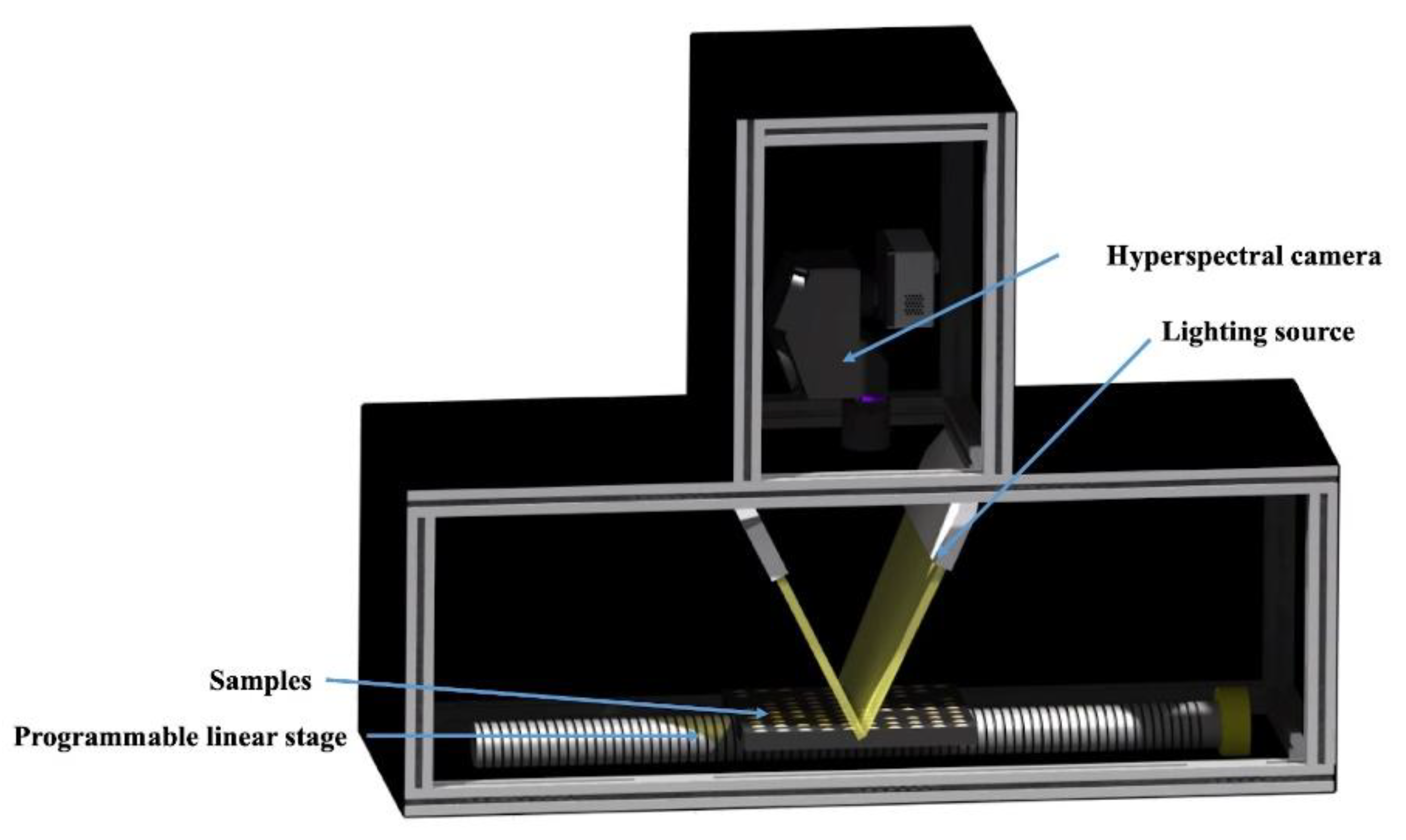
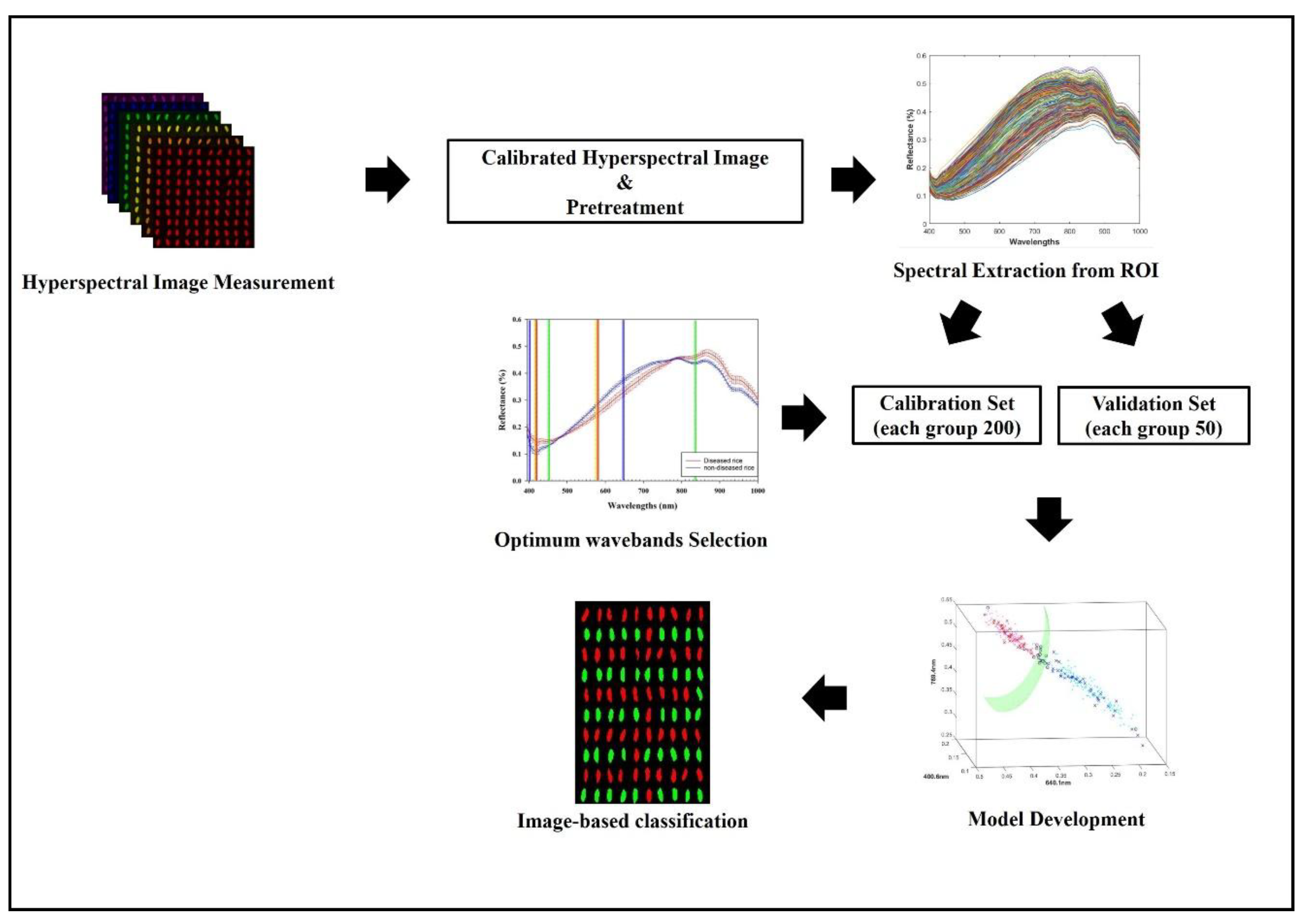
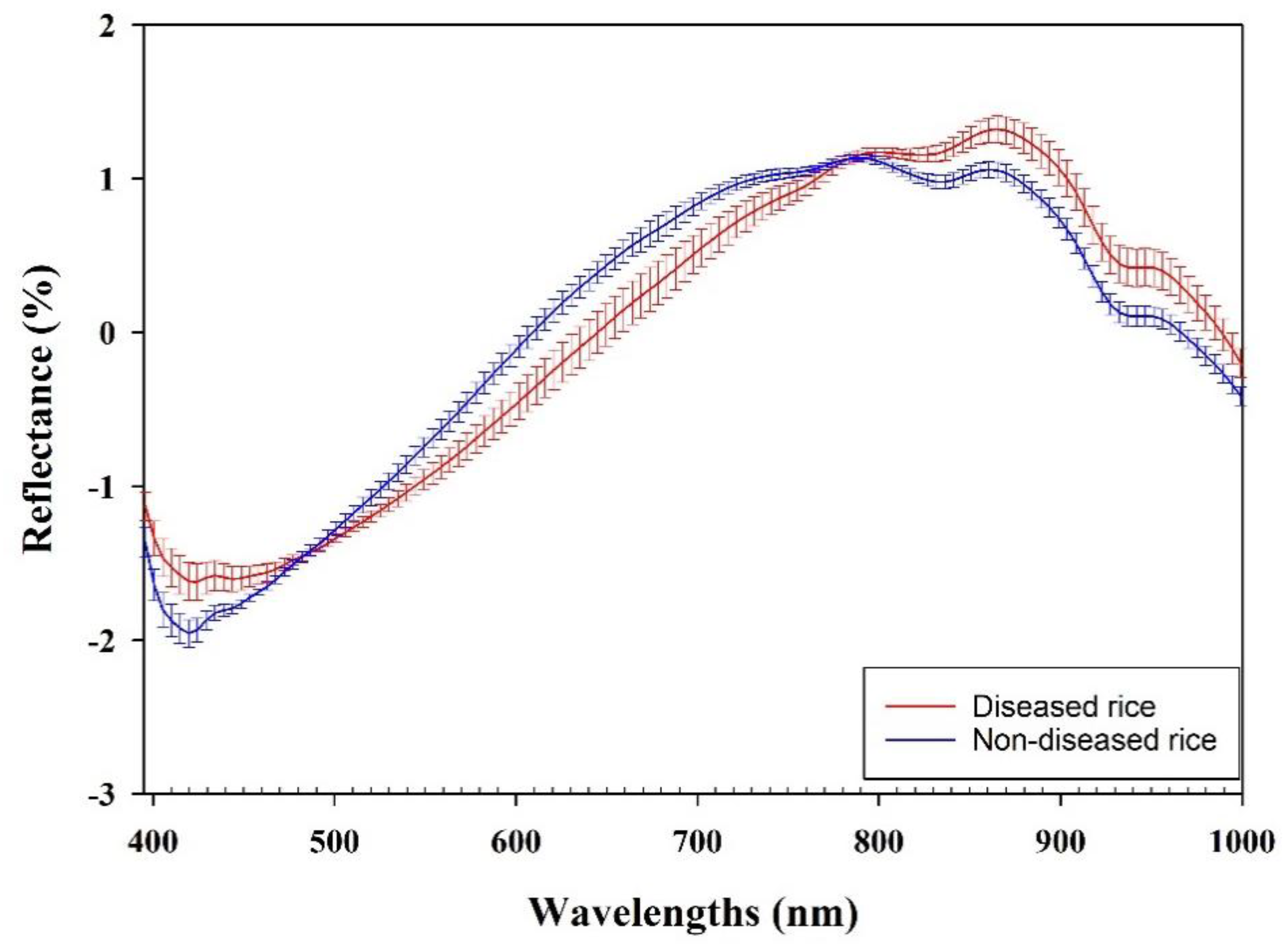
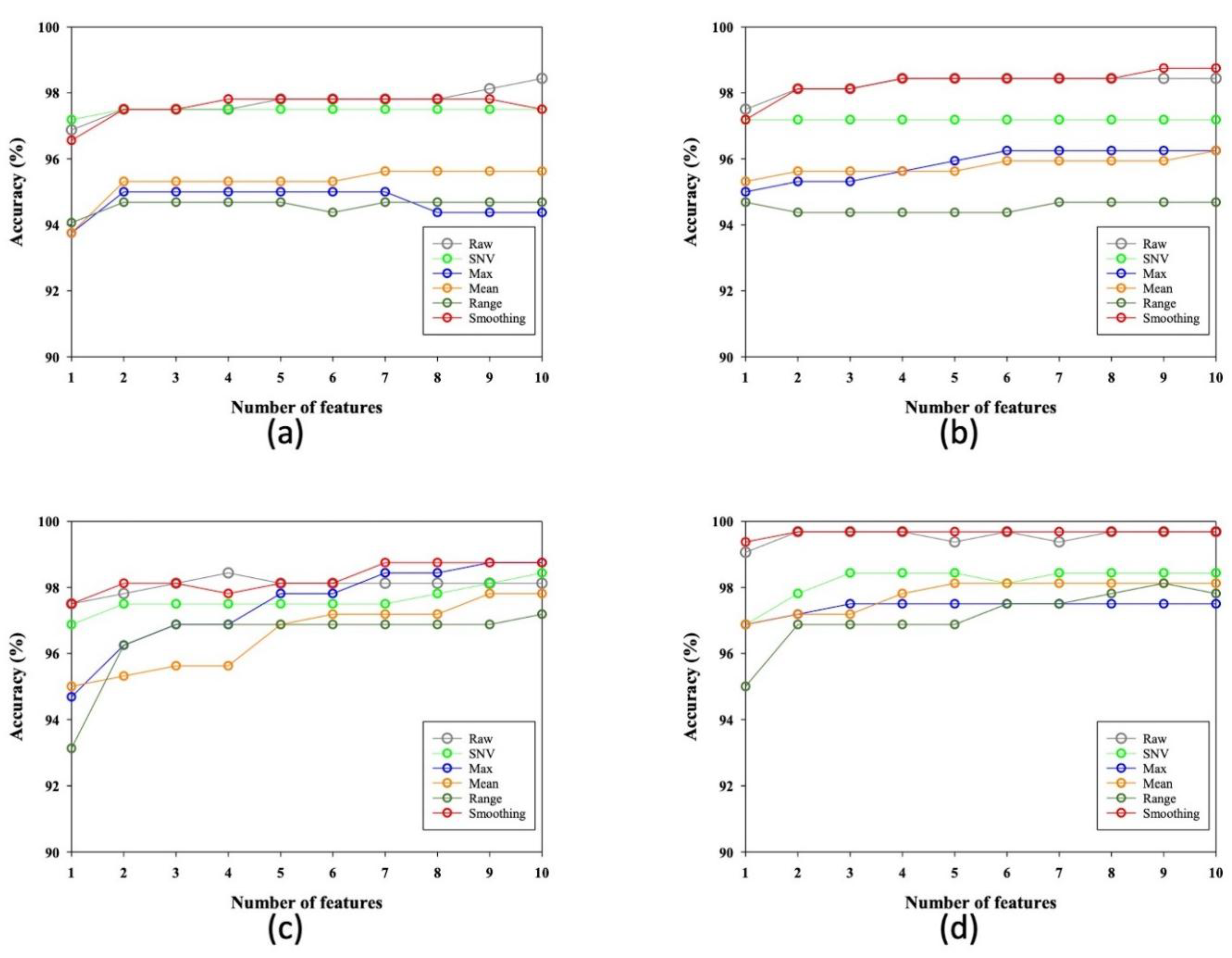
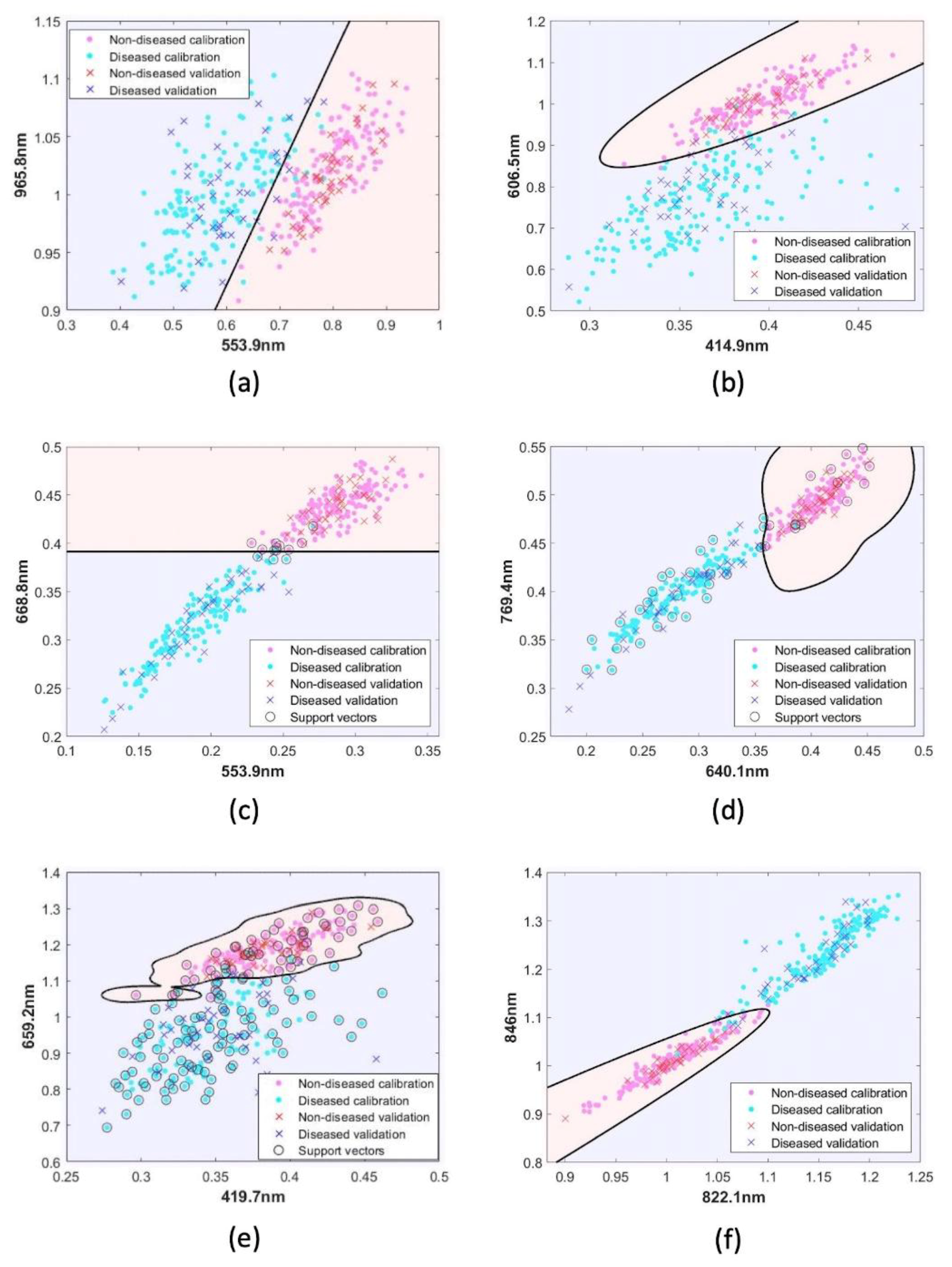

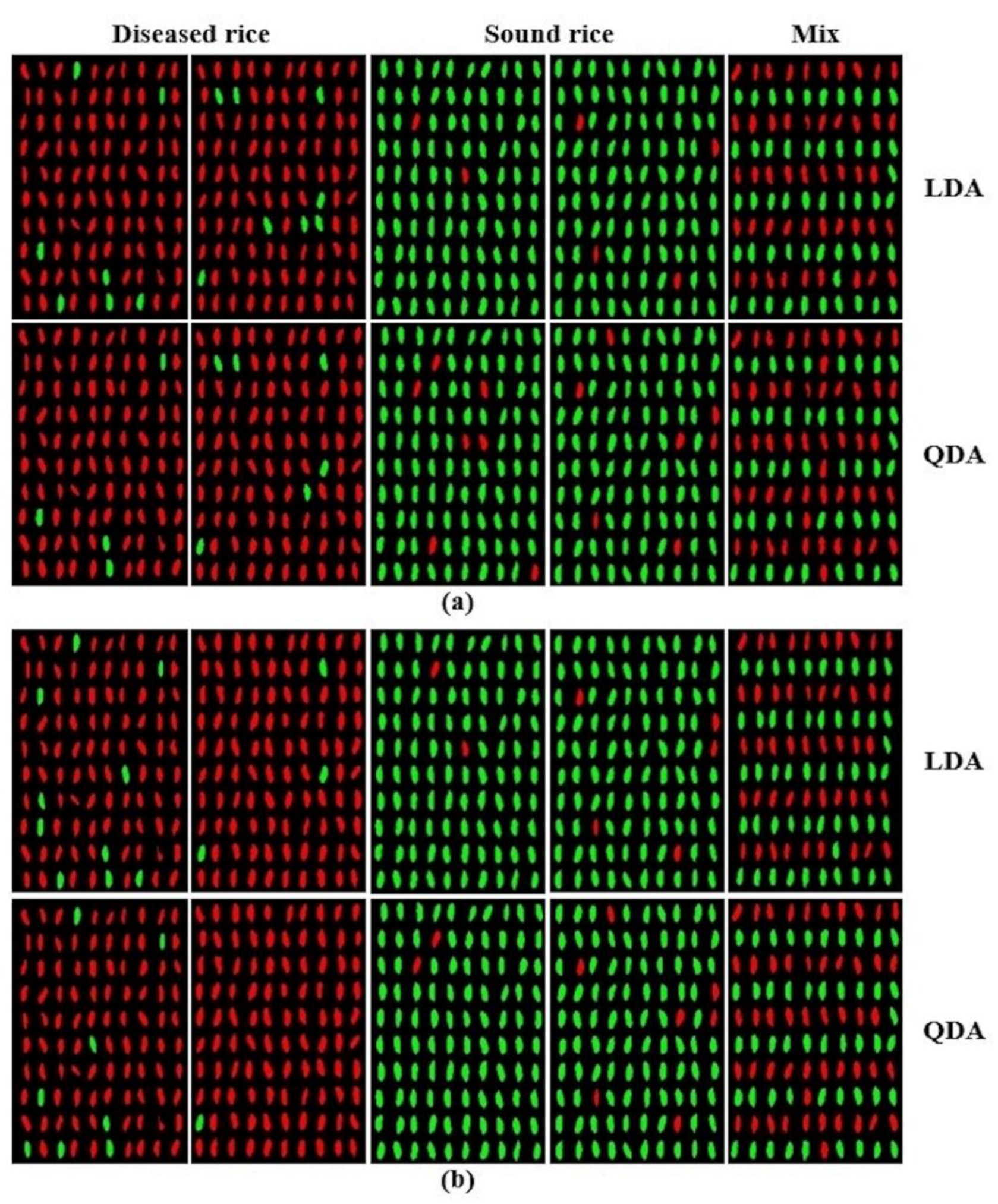
| Normalization | Maximum | ||
| Mean | |||
| Range | |||
| SNV | : average value of the sample spectrum : standard deviation of the sample-spectrum | ||
| Smoothing |
| Classifier | Pretreatment | 1st Band (nm) | 2nd Band (nm) | 3rd Band (nm) |
|---|---|---|---|---|
| SVM | Raw | 396 | 554 | 669 |
| SNV | 458 | 846 | 961 | |
| Max normalization | 607 | 621 | 631 | |
| Mean normalization | 396 | 611 | 870 | |
| Range normalization | 401 | 640 | 669 | |
| Smoothing | 396 | 501 | 664 | |
| SVM with RBF | Raw | 401 | 640 | 769 |
| SNV | 463 | 468 | 635 | |
| Max normalization | 396 | 621 | 674 | |
| Mean normalization | 396 | 401 | 875 | |
| Range normalization | 405 | 420 | 659 | |
| Smoothing | 401 | 635 | 750 | |
| LDA | Raw | 396 | 583 | 741 |
| SNV | 396 | 453 | 846 | |
| Max normalization | 559 | 563 | 865 | |
| Mean normalization | 410 | 765 | 865 | |
| Range normalization | 554 | 966 | 985 | |
| Smoothing | 396 | 578 | 741 | |
| QDA | Raw | 420 | 635 | 640 |
| SNV | 822 | 846 | 880 | |
| Max normalization | 712 | 789 | 899 | |
| Mean normalization | 640 | 918 | 956 | |
| Range normalization | 415 | 607 | 827 | |
| Smoothing | 420 | 631 | 990 |
| Classifier | Pretreatment | Calibration (%) | Total (%) | Validation (%) | Total (%) | ||
|---|---|---|---|---|---|---|---|
| Diseased | Sound | Diseased | Sound | ||||
| LDA | RAW | 92.5 | 97 | 94.8 | 96 | 100 | 98 |
| SNV | 92.5 | 100 | 96.3 | 96 | 98 | 97 | |
| Max normalization | 94.5 | 98.5 | 96.5 | 98 | 100 | 99 | |
| Mean normalization | 84.5 | 100 | 92.3 | 96 | 100 | 98 | |
| Range normalization | 86 | 99.5 | 92.8 | 94 | 100 | 97 | |
| Smoothing | 92.5 | 97 | 94.8 | 96 | 100 | 98 | |
| QDA | RAW | 95.5 | 93 | 94.3 | 98 | 92 | 95 |
| SNV | 92.5 | 99.5 | 96 | 98 | 100 | 99 | |
| Max normalization | 91 | 99.5 | 95.3 | 94 | 94 | 94 | |
| Mean normalization | 91 | 99.5 | 95.3 | 94 | 98 | 96 | |
| Range normalization | 91 | 99 | 95 | 98 | 100 | 99 | |
| Smoothing | 95 | 93 | 94 | 98 | 92 | 95 | |
| C-SVM | RAW | 96.5 | 88.5 | 92.5 | 98 | 86 | 92 |
| SNV | 88.5 | 99.5 | 94 | 94 | 100 | 97 | |
| Max normalization | 91 | 99.5 | 95.3 | 98 | 98 | 98 | |
| Mean normalization | 91 | 99 | 95 | 98 | 100 | 99 | |
| Range normalization | 90 | 98.5 | 94.3 | 94 | 100 | 97 | |
| Smoothing | 96 | 89 | 92.5 | 98 | 86 | 92 | |
| SVM with RBF | RAW | 96 | 93.5 | 95.8 | 98 | 92 | 95 |
| SNV | 89 | 99.5 | 94.3 | 96 | 100 | 98 | |
| Max normalization | 93.5 | 96 | 94.8 | 98 | 98 | 98 | |
| Mean normalization | 89.5 | 100 | 94.8 | 96 | 100 | 98 | |
| Range normalization | 90.5 | 94.5 | 92.5 | 96 | 92 | 94 | |
| Smoothing | 94.5 | 93.5 | 94 | 98 | 92 | 95 | |
| Classifier | Pretreatment | Calibration (%) | Total (%) | Validation (%) | Total (%) | ||
|---|---|---|---|---|---|---|---|
| Diseased | Sound | Diseased | Sound | ||||
| LDA | RAW | 92 | 95 | 93.5 | 96 | 98 | 97 |
| SNV | 93 | 100 | 96.5 | 98 | 98 | 98 | |
| Max normalization | 94 | 99 | 96.5 | 98 | 98 | 98 | |
| Mean normalization | 88 | 99.5 | 93.8 | 96 | 100 | 98 | |
| Range normalization | 91.5 | 99.5 | 95.5 | 98 | 100 | 99 | |
| Smoothing | 93.5 | 96.5 | 95 | 96 | 100 | 98 | |
| QDA | RAW | 95 | 93.5 | 94.3 | 98 | 94 | 96 |
| SNV | 94 | 99.5 | 96.8 | 100 | 98 | 99 | |
| Max normalization | 93 | 99.5 | 96.3 | 98 | 94 | 96 | |
| Mean normalization | 92.5 | 98.5 | 95.5 | 98 | 98 | 98 | |
| Range normalization | 93 | 98.5 | 95.8 | 98 | 98 | 98 | |
| Smoothing | 95.5 | 95.5 | 95.5 | 98 | 96 | 97 | |
| C-SVM | RAW | 96.5 | 88.5 | 92.5 | 98 | 88 | 93 |
| SNV | 90.5 | 99.5 | 95 | 94 | 100 | 97 | |
| Max normalization | 92.5 | 99 | 95.8 | 98 | 100 | 99 | |
| Mean normalization | 92 | 98.5 | 95.3 | 99.5 | 100 | 99.8 | |
| Range normalization | 94 | 98 | 96 | 98 | 98 | 98 | |
| Smoothing | 95.5 | 87.5 | 91.5 | 98 | 88 | 93 | |
| SVM with RBF | RAW | 94 | 91 | 92.5 | 96 | 90 | 93 |
| SNV | 95 | 98.5 | 96.8 | 98 | 98 | 98 | |
| Max normalization | 94 | 98 | 96 | 98 | 96 | 97 | |
| Mean normalization | 91.5 | 99 | 95.3 | 98 | 98 | 98 | |
| Range normalization | 93.5 | 95 | 94.3 | 96 | 98 | 97 | |
| Smoothing | 94 | 91 | 92.5 | 96 | 90 | 93 | |
© 2019 by the authors. Licensee MDPI, Basel, Switzerland. This article is an open access article distributed under the terms and conditions of the Creative Commons Attribution (CC BY) license (http://creativecommons.org/licenses/by/4.0/).
Share and Cite
Baek, I.; Kim, M.S.; Cho, B.-K.; Mo, C.; Barnaby, J.Y.; McClung, A.M.; Oh, M. Selection of Optimal Hyperspectral Wavebands for Detection of Discolored, Diseased Rice Seeds. Appl. Sci. 2019, 9, 1027. https://doi.org/10.3390/app9051027
Baek I, Kim MS, Cho B-K, Mo C, Barnaby JY, McClung AM, Oh M. Selection of Optimal Hyperspectral Wavebands for Detection of Discolored, Diseased Rice Seeds. Applied Sciences. 2019; 9(5):1027. https://doi.org/10.3390/app9051027
Chicago/Turabian StyleBaek, Insuck, Moon S. Kim, Byoung-Kwan Cho, Changyeun Mo, Jinyoung Y. Barnaby, Anna M. McClung, and Mirae Oh. 2019. "Selection of Optimal Hyperspectral Wavebands for Detection of Discolored, Diseased Rice Seeds" Applied Sciences 9, no. 5: 1027. https://doi.org/10.3390/app9051027
APA StyleBaek, I., Kim, M. S., Cho, B.-K., Mo, C., Barnaby, J. Y., McClung, A. M., & Oh, M. (2019). Selection of Optimal Hyperspectral Wavebands for Detection of Discolored, Diseased Rice Seeds. Applied Sciences, 9(5), 1027. https://doi.org/10.3390/app9051027







